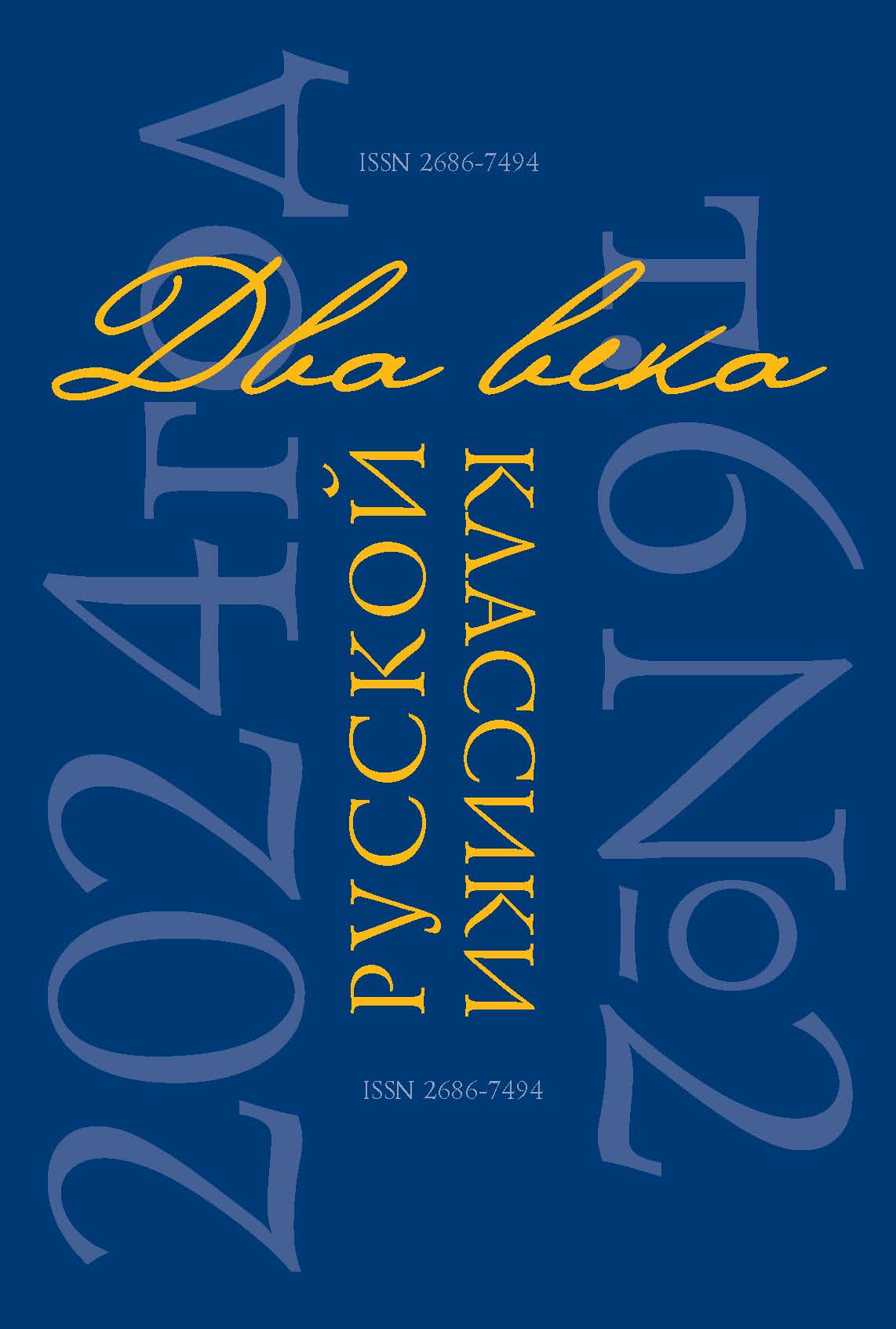Abstract: The article considers the image of the earth in Leo Tolstoy’s novels as one of several “epic constants” of the writer’s artistic work. Leo Tolstoy states that the complete separation of man from the earth gradually leads to oblivion of spiritual life, to a loss of understanding of the value of national unity. The image of the earth connects all Leo Tolstoy’s novels, promotes the organisation of religious consciousness, and becomes key in the late work of the writer who dreamed of transferring land for public use according to the system of American publicist and political economist Henry George. Birth and death, the situation of war and the image of the earth become original criteria in Leo Tolstoy’s epic artistic worlds — all four of these concepts are not only semantic centres, but also measures for Leo Tolstoy’s heroes. The enduring epic foundations analysed in the article make it possible to comprehend the features of Leo Tolstoy’s historicism, the connection between the individual and the people. The author of the article shows that after the “War and Peace”, Leo Tolstoy’s orientation to epic breadth was caused by a desire to maintain the scale found, to embody it on new material of his contemporary life. In the artistic world of “Anna Karenina”, a special concentration of epic foundations is noted, and in “Resurrection” the epic essence of the novel is explained by a national catastrophe, a threat hanging over the Russian people and putting it on the brink of extinction.
References
Alekseeva N. Iu. Nekotorye zamechaniia po povodu raboty nad istoriei russkoi literatury [Some comments on the work on the history of Russian literature]. Russkaia literature [Russian literature], 2018, № 4. pp. 7–14. DOI: 10.31860/0131-6095-2018-4-7-1
Andreeva V. G. «Beskonechnyi labirint stseplenii» v romane L. N. Tolstogo «Anna Karenina» [“The Endless Labyrinth of Couplings” in the novel by Leo Tolstoy “Anna Karenina”]. Kostroma, Avantitul Publ., 2012, 296 p.
Andreeva V. G. O natsional'nom svoeobrazii russkogo romana vtoroi poloviny XIX veka [About the national identity of the Russian novel of the second half of the XIX century]. Kostroma, KGU Publ., 2016, 492 p.
Bekedin P. V. Epopeia: nekotorye voprosy genezisa zhanra [Epic: some questions of the genesis of the genre]. Russkaia literature [Russian literature], 1976, № 4, pp. 34–60.
Bocharov S. G. Roman Tolstogo “Voina i mir” [Tolstoy’s novel “War and Peace”]. Moscow, Khud. lit. Publ., 1987, 156 p.
Bursov B. I. Lev Tolstoi [Leo Tolstoy] Istoriia russkoi literatury v 9 t. T. 9. [History of Russian literature in 9 vols. Vol. 9]. Moscow, Leningrad, Akad. Nauk Publ., 1956, pp. 435–625.
Galagan G. Ia. L. N. Tolstoi [Leo Tolstoy]. Istoriia russkoi literatury v 4 t. T. 3. [History of Russian literature in 4 vols. Vol. 3]. Leningrad, Nauka Publ., 1982, pp. 797–851.
Gachev G. D. Soderzhatel'nost' khudozhestvennykh form [The content of art forms]. Moscow, Prosveshchenie Publ, 1968, 302 p.
Dostoevskii F. M. Poln. sobr. soch.: v 30 t. T. 29, kn. 1. [Full collection of works in 30 vols. Vol. 29, book 1]. Leningrad: Nauka Publ., 1986, 573 p.
Zverev A. M., Tunimanov V. A. Lev Tolstoi [Leo Tolstoy]. Moscow, Molodaia gvardiia Publ., 2007, 782 p.
Karpov I. P. Poetika ontologicheskoi situatsii (L. N. Tolstoi. «Voina i mir». Smert' Andreia Bolkonskogo) [Poetics of the ontological situation (L. N. Tolstoy. “War and Peace.” Death of Andrei Bolkonsky)] Vestnik Viatskogo gosudarstvennogo gumanitarnogo universiteta [Bulletin of the Vyatka State Humanitarian University], 2009, № 1, pp. 85–94.
Kupreianova E. N. “Voina i mir” i “Anna Karenina” L'va Tolstogo [“War and Peace” and “Anna Karenina” by Leo Tolstoy] Istoriia russkogo romana v 2 t. T. 2 [History of the Russian novel in 2 vols. Vol. 2.]. Moscow, Leningrad, Nauka Publ., 1964, pp. 270–349.
Lebedev Iu. V. L. N. Tolstoi na puti k “Voine i miru” (Sevastopol' i Sevastopol'skie rasskazy) [L. N. Tolstoy on the way to “War and Peace” (Sevastopol and Sevastopol Stories)] Russkaia literature [Russian literature], 1976, № 4, pp. 61–82.
Lebedev Iu. V. O religioznykh motivakh v “Voine i mire” L. N. Tolstogo [On religious motives in “War and Peace” by Leo Tolstoy] Vestnik Kostromskogo gosudarstvennogo universiteta [Vestnik of Kostroma state university], 2016, № 2, pp. 95–100.
Lomunov K. N. Nad stranitsami “Voskreseniia”. Istoriia sozdaniia romana L. N. Tolstogo. Problemy, obrazy, kharaktery. Pervye otkliki. Nashi sovremenniki o romane [Above the Resurrection pages. The story of the creation of the novel by L. N. Tolstoy. Problems, images, characters. First responses. Our contemporaries about the novel]. Moscow, Sovremennik Publ., 1978, 381 p.
Masolova E. A. Stanovlenie epicheskogo v Sevastopol'skikh rasskazakh L. N. Tolstogo [The formation of the epic in the Sevastopol stories of Leo Tolstoy] Uchenye zapiski Kazanskogo universiteta. Seriia: Gumanitarnye nauki [Scientific notes of Kazan University. Series: Humanities]. 2016, Vol. 158, № 1, pp. 133–145.
Mishin V. S. Kommentarii [Comments] Tolstoi L. N. Poln. sobr. soch. v 90 t. T. 90. [Full collection of works in 90 vols. Vol. 90]. Moscow: Khud. lit. Publ, 1958, pp. 355–417.
Nikitina N. A. Povsednevnaia zhizn' L'va Tolstogo v Iasnoi Poliane [The daily life of Leo Tolstoy in Yasnaya Polyana]. Moscow, Molodaia gvardiia Publ, 2007, 395 p.
Parshin A. N. “Bogoroditsa – mat' syra zemlia» (O trekh lektsiiakh v Moskovskoi dukhovnoi akademii) [“The Virgin Mary is the mother of the earth’s cheese” (On three lectures at the Moscow Theological Academy)] Vestnik pravoslavnogo Sviato-tikhonovskogo gumanitarnogo universiteta. Seriia 1. Bogoslovie. Filosofiia [Bulletin of the Orthodox St. Tikhon Humanitarian University. Series 1. Theology. Philosophy]. 2011, № 5(37), pp. 71–81.
Pushkina O. I. Obraz materi – syroi zemli kak eksplikatsiia aksiologicheskikh dominant vostochnykh slavian [The image of mother – raw land as an explication of axiological dominants of the Eastern Slavs] Aksiologicheskii diapazon khudozhestvennoi literatury [Axiological range of fiction]. Vitebsk, Vitebskii gosudarstvennyi universitet im. P. M. Masherova Publ, 2017, pp. 290–293.
Smirnov S. I. Drevnerusskii dukhovnik [Old Russian confessor]. Moscow, Pravosl. Sv.-Tikhon. Bogosl. in-t Publ, 2004, 553 p.
Sukhotina T. A. Vospominaniia [Memories]. Moscow, Khud. lit. Publ, 1976, 541 p.
Tolstoi L. N. Poln. sobr. soch. v 90 t. [Full collection of works in 90 vols.]. Moscow: Khud. lit. Publ., 1928–1958. (In Russ.)
Fedotov G. P. Mat'-Zemlia. K religioznoi kosmologii russkogo naroda [Mother Earth. To the religious cosmology of the Russian people]. Put' [Way] 1935, № 46, pp. 3–18.
Eikhenbaum B. M. Lev Tolstoi. Semidesiatye gody [Leo Tolstoy. Seventies]. Leningrad, Khud. lit. Publ., 1974, 360 p.









